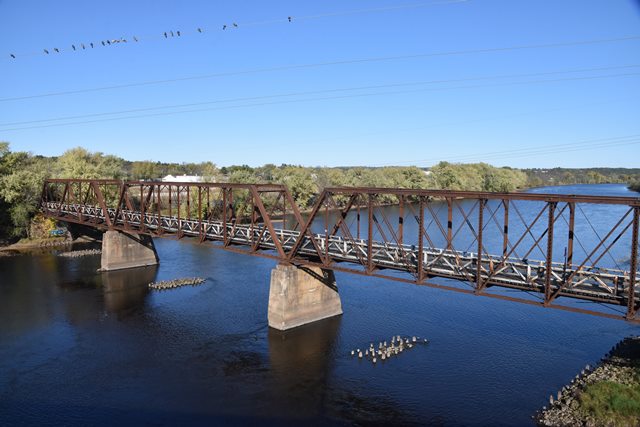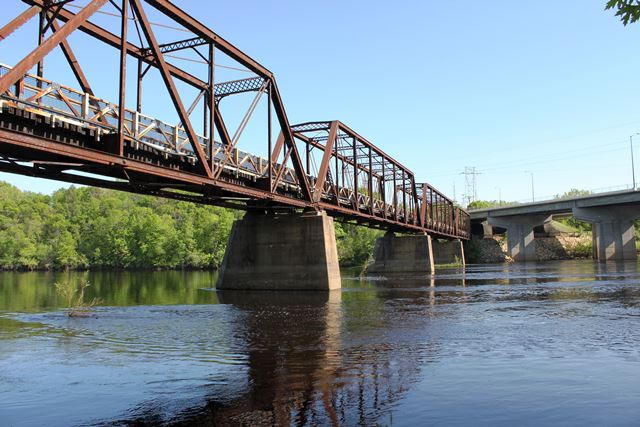We Recommend:
Bach Steel - Experts at historic truss bridge restoration.
BridgeHunter.com Phase 1 is released to the public! - Visit Now
Clairemont Avenue Railroad Bridge

Primary Photographer(s): Nathan Holth
Bridge Documented: May 12, 2012 and October 17, 2021
Railroad (Chippewa River State Rail-Trail) Over Chippewa River
Eau Claire: Eau Claire County, Wisconsin: United States
Metal 8 Panel Pin-Connected Pratt Through Truss, Fixed and Approach Spans: Metal 6 Panel Pin-Connected Warren Through Truss, Fixed
1886 By Builder/Contractor: Union Bridge Company of Athens, Pennsylvania and Buffalo, New York
1911
145.0 Feet (44.2 Meters)
670.0 Feet (204.2 Meters)
Not Available
3 Main Span(s) and 8 Approach Span(s)
Not Applicable

View Information About HSR Ratings
Bridge Documentation
This is a very old example of a railroad truss bridge, and it is unusual because it has four truss spans with three different designs. Three spans are Pratt truss spans, but one of those spans has a slightly different portal bracing, which lacks a pointed shape at the top found on the other two. Then there is the pin-connected Warren truss span. It also lacks a pointed portal bracing. Pin-connected Warren truss bridges are extremely rare, and this railroad example is particularly rare and significant.
It is not known why such a variety of design details appears on this bridge. Could the spans have been relocated from other crossings and reused here? Stylistically, they all appear to be from the same era, which tends to suggest that this bridge's story isn't a case of a couple original spans being destroyed by flood or derailment decades after original construction and being replaced with new spans... however those types of disasters could also be a cause for relocating and reusing spans from elsewhere here. One span has an 1886 plaque crediting the Union Bridge Company with building that span, but given the design differences in the other spans, it is not known if this company built the other spans. All that is known is that there is no coincidence that this bridge has these design differences among the spans. There is a story hidden here. What that story is remains a mystery!
At the north end of the bridge, there are six timber trestle spans. Then, from north to south, there are four main truss spans, ordered as follows. First, a pin-connected Warren through truss with a rectangular shaped portal bracing, six panels. Next, two eight panel pin-connected Pratt through truss spans featuring portal bracing that comes to a point at the top. Finally, a seven panel pin-connected Pratt through truss, but this span is without the pointed portal bracing and has a more traditional rectangular portal bracing. Finally, the bridge ends at the southern end with a concrete slab span.
The bridge's truss spans appear to be largely unaltered, giving the bridge's spans good historic integrity. The bridge has been converted for pedestrian use. The bridge was originally built for the Chicago, Milwaukee, St. Paul & Pacific Railroad (Milwaukee Road). It was abandoned in 1981 and converted to pedestrian use around 2004.
John Marvig provided some additional information on this bridge which answered some of the questions this bridge initially presented. From south to north, a detailed description and history. Date comes from the Milwaukee Road Archives and the Milwaukee Central Library 1-19' Concrete Slab (Built 1911) 1-127'9" Pin Connected Pratt Through Truss, Relocated from the Minnesota River Crossing at Chaska, Minnesota in 1911, originally built 1886 to cross the Zumbro River, at Kellogg, Minnesota. 2-142' Pin Connected Pratt Through Trusses, relocated from Des Moines River crossing at Ottumwa in 1911, originally built 1887. 1-134'6" Pin Connected Warren Through Truss, relocated from Madrid, Iowa crossing of the Des Moines River in 1911, originally built 1888 7-14' Timber Trestle spans, built 1969.
This bridge is tagged with the following special condition(s): Unorganized Photos
![]()
Photo Galleries and Videos: Clairemont Avenue Railroad Bridge
2012 Bridge Photo-Documentation
Original / Full Size PhotosA collection of overview and detail photos. This gallery offers photos in the highest available resolution and file size in a touch-friendly popup viewer.
Alternatively, Browse Without Using Viewer
![]()
2012 Bridge Photo-Documentation
Mobile Optimized PhotosA collection of overview and detail photos. This gallery features data-friendly, fast-loading photos in a touch-friendly popup viewer.
Alternatively, Browse Without Using Viewer
![]()
2021 Additional Unorganized Photos
Original / Full Size PhotosA supplemental collection of photos that are from additional visit(s) to the bridge and have not been organized or captioned. This gallery offers photos in the highest available resolution and file size in a touch-friendly popup viewer.
Alternatively, Browse Without Using Viewer
![]()
2021 Additional Unorganized Photos
Mobile Optimized PhotosA supplemental collection of photos that are from additional visit(s) to the bridge and have not been organized or captioned. This gallery features data-friendly, fast-loading photos in a touch-friendly popup viewer.
Alternatively, Browse Without Using Viewer
![]()
Maps and Links: Clairemont Avenue Railroad Bridge
Coordinates (Latitude, Longitude):
Search For Additional Bridge Listings:
Bridgehunter.com: View listed bridges within 0.5 miles (0.8 kilometers) of this bridge.
Bridgehunter.com: View listed bridges within 10 miles (16 kilometers) of this bridge.
Additional Maps:
Google Streetview (If Available)
GeoHack (Additional Links and Coordinates)
Apple Maps (Via DuckDuckGo Search)
Apple Maps (Apple devices only)
Android: Open Location In Your Map or GPS App
Flickr Gallery (Find Nearby Photos)
Wikimedia Commons (Find Nearby Photos)
Directions Via Sygic For Android
Directions Via Sygic For iOS and Android Dolphin Browser
USGS National Map (United States Only)
Historical USGS Topo Maps (United States Only)
Historic Aerials (United States Only)
CalTopo Maps (United States Only)



